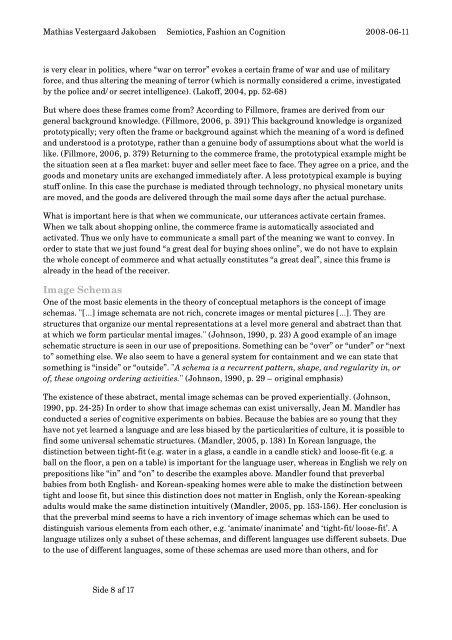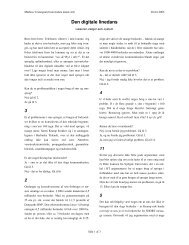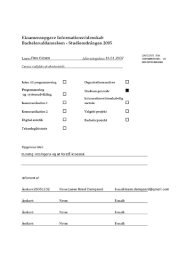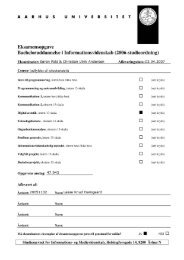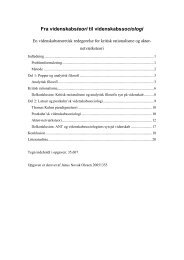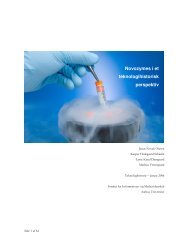Semiotics, Fashion and Cognition - Mathias Vestergaard Corp.
Semiotics, Fashion and Cognition - Mathias Vestergaard Corp.
Semiotics, Fashion and Cognition - Mathias Vestergaard Corp.
Create successful ePaper yourself
Turn your PDF publications into a flip-book with our unique Google optimized e-Paper software.
<strong>Mathias</strong> <strong>Vestergaard</strong> Jakobsen <strong>Semiotics</strong>, <strong>Fashion</strong> an <strong>Cognition</strong> 2008-06-11<br />
is very clear in politics, where “war on terror” evokes a certain frame of war <strong>and</strong> use of military<br />
force, <strong>and</strong> thus altering the meaning of terror (which is normally considered a crime, investigated<br />
by the police <strong>and</strong>/or secret intelligence). (Lakoff, 2004, pp. 52-68)<br />
But where does these frames come from? According to Fillmore, frames are derived from our<br />
general background knowledge. (Fillmore, 2006, p. 391) This background knowledge is organized<br />
prototypically; very often the frame or background against which the meaning of a word is defined<br />
<strong>and</strong> understood is a prototype, rather than a genuine body of assumptions about what the world is<br />
like. (Fillmore, 2006, p. 379) Returning to the commerce frame, the prototypical example might be<br />
the situation seen at a flea market: buyer <strong>and</strong> seller meet face to face. They agree on a price, <strong>and</strong> the<br />
goods <strong>and</strong> monetary units are exchanged immediately after. A less prototypical example is buying<br />
stuff online. In this case the purchase is mediated through technology, no physical monetary units<br />
are moved, <strong>and</strong> the goods are delivered through the mail some days after the actual purchase.<br />
What is important here is that when we communicate, our utterances activate certain frames.<br />
When we talk about shopping online, the commerce frame is automatically associated <strong>and</strong><br />
activated. Thus we only have to communicate a small part of the meaning we want to convey. In<br />
order to state that we just found “a great deal for buying shoes online”, we do not have to explain<br />
the whole concept of commerce <strong>and</strong> what actually constitutes “a great deal”, since this frame is<br />
already in the head of the receiver.<br />
Image Schemas<br />
One of the most basic elements in the theory of conceptual metaphors is the concept of image<br />
schemas. "[…] image schemata are not rich, concrete images or mental pictures […]. They are<br />
structures that organize our mental representations at a level more general <strong>and</strong> abstract than that<br />
at which we form particular mental images." (Johnson, 1990, p. 23) A good example of an image<br />
schematic structure is seen in our use of prepositions. Something can be “over” or “under” or “next<br />
to” something else. We also seem to have a general system for containment <strong>and</strong> we can state that<br />
something is “inside” or “outside”. "A schema is a recurrent pattern, shape, <strong>and</strong> regularity in, or<br />
of, these ongoing ordering activities." (Johnson, 1990, p. 29 – original emphasis)<br />
The existence of these abstract, mental image schemas can be proved experientially. (Johnson,<br />
1990, pp. 24-25) In order to show that image schemas can exist universally, Jean M. M<strong>and</strong>ler has<br />
conducted a series of cognitive experiments on babies. Because the babies are so young that they<br />
have not yet learned a language <strong>and</strong> are less biased by the particularities of culture, it is possible to<br />
find some universal schematic structures. (M<strong>and</strong>ler, 2005, p. 138) In Korean language, the<br />
distinction between tight-fit (e.g. water in a glass, a c<strong>and</strong>le in a c<strong>and</strong>le stick) <strong>and</strong> loose-fit (e.g. a<br />
ball on the floor, a pen on a table) is important for the language user, whereas in English we rely on<br />
prepositions like “in” <strong>and</strong> “on” to describe the examples above. M<strong>and</strong>ler found that preverbal<br />
babies from both English- <strong>and</strong> Korean-speaking homes were able to make the distinction between<br />
tight <strong>and</strong> loose fit, but since this distinction does not matter in English, only the Korean-speaking<br />
adults would make the same distinction intuitively (M<strong>and</strong>ler, 2005, pp. 153-156). Her conclusion is<br />
that the preverbal mind seems to have a rich inventory of image schemas which can be used to<br />
distinguish various elements from each other, e.g. ‘animate/inanimate’ <strong>and</strong> ‘tight-fit/loose-fit’. A<br />
language utilizes only a subset of these schemas, <strong>and</strong> different languages use different subsets. Due<br />
to the use of different languages, some of these schemas are used more than others, <strong>and</strong> for<br />
Side 8 af 17


